Stitches in Time: - - - - - - - - -
- - - - - 100 Years of Machines and Sewing
June 4 - September 26, 2004
Intro - - -
Technology - - -
Machines - - -
Impact - - -
Quotes - - -
Inventors
Inventors
Thomas Saint ---
Walter Hunt ---
Barthelemy Thimonnier ---
Elias Howe, Jr. ---
Isaac Merritt Singer ---
Allen Benjamin Wilson ---
Helen Blanchard
...I often heard (Elias Howe) say that he worked 14 years to get up that sewing machine. But his wife made up her mind one day that they would starve to death if there wasn't something or other invented pretty soon, and so in two hours she invented the sewing machine. Of course he took out the patent in his name. Men always do that.
-Russell Conwell, 1877
As intriguing as this statement is, we will never know if the credit for the first sewing machine should actually go to Elizabeth Ames Howe. What we do know is that of the thousands of sewing machine patents granted in the past 150 years, hundreds of them have been for women's inventions.
Many inventors, both men and women, contributed to the sewing machine we
know today. The first sewing machine was patented in 1790, and many key
innovations were made over the next century. Read on to find out more about
the people who created a "household necessity," one invention at a time.
Thomas Saint
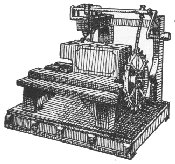 Not much is known about the life of Thomas Saint, the London cabinet maker who usually takes credit for patenting the first sewing machine in 1790. The patent was ponderously entitled, "An Entire New Method of Making and Completing Shoes, Boots, Splatterdashes, Clogs, and Other Articles, by Means of Tools and Machines also Invented by Me for that Purpose, and of Certain Compositions of the Nature of Japan or Varnish, which will be very advantageous in many useful Appliances." People overlooked it for 83 years because it was classed under wearing apparel.
Not much is known about the life of Thomas Saint, the London cabinet maker who usually takes credit for patenting the first sewing machine in 1790. The patent was ponderously entitled, "An Entire New Method of Making and Completing Shoes, Boots, Splatterdashes, Clogs, and Other Articles, by Means of Tools and Machines also Invented by Me for that Purpose, and of Certain Compositions of the Nature of Japan or Varnish, which will be very advantageous in many useful Appliances." People overlooked it for 83 years because it was classed under wearing apparel.
The patent contains, among many other things, descriptions of three separate machines; the second of these was for "stitching, quilting, or sewing." Though far from practical, the machine incorporated several features common to a modern sewing machine.
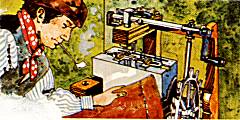 It had a horizontal cloth plate or table, an overhanging arm carrying a straight needle, and a continuous supply of thread from a spool. A rotating hand crank on a shaft activated cams that produced all the machine's actions.
It had a horizontal cloth plate or table, an overhanging arm carrying a straight needle, and a continuous supply of thread from a spool. A rotating hand crank on a shaft activated cams that produced all the machine's actions.
Saint probably never built even one machine and people who have tried to reconstruct one following his plans had to modify the construction before it would stitch at all. Nevertheless, the idea was there, at the end of the 18th century.
Walter Hunt (1796-1860)
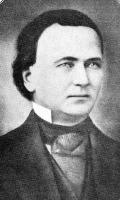 Born in New York, Walter Hunt spent most of his life as an inventor. He was known for his generosity, despite his lack of wealth.
Born in New York, Walter Hunt spent most of his life as an inventor. He was known for his generosity, despite his lack of wealth.
Sometime between 1832 and 1834 he produced a sewing machine that made a lock stitch. It represented the first time an inventor had not attempted to reproduce a hand stitch. Future inventors were thus no longer hampered by the idea that the sewing machine must imitate the human hand and fingers.
The lock stitch required two threads, one passing through a loop in the other and both interlocking in the heart of the seam. Hunt did not consider his invention any more promising than several of his others, and he sold his interest for a small sum.
His first patent, in 1826, was for a machine to spin flax and hemp. During the next 33 years, Hunt obtained 26 patents, for the sewing machine and other inventions as diverse as a coach alarm, fountain pen, safety pin, and paper collars.
Barthelemy Thimonnier (1793-1857)
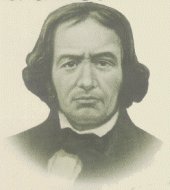 The first man known to have put a sewing machine into practical operation, Barthelemy Thimonnier was a French tailor in the early 19th century. Noting that weaving was much faster than hand-sewing a garment, he began thinking of a method to mechanize sewing.
The first man known to have put a sewing machine into practical operation, Barthelemy Thimonnier was a French tailor in the early 19th century. Noting that weaving was much faster than hand-sewing a garment, he began thinking of a method to mechanize sewing.
Many people in his village did a type of embroidery using a needle with a small hook, forming a chain stitch. Thimonnier planned to use this type of hooked needle and produce the stitch by machine. Although he had no mechanical background, he succeeded in his efforts. In 1830 he received a patent on his machine, which produced a chain stitch by means of a needle shaped like a small crochet hook.
By 1840 he had a shop in Paris with 80 machines in use sewing uniforms for the French army. But tailors were fearful of the new machines as a threat to their jobs, and a mob destroyed the factory and the machines.
Undaunted, he found backing and opened another sewing machine factory; this time the French Revo-lution of 1848 curtailed his effort. He subsequently moved to England, where he also received a patent. He also received a U.S. patent; however, by this time other inventors had joined the field with more practical machines. He died in poverty in 1857.
Elias Howe, Jr. (1819-67)
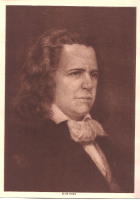 Massachusetts-born Elias Howe was inspired to invent a sewing machine when he was in ill health and his wife took in sewing to earn money. Watching her toiling at her stitches rekindled an earlier interest in such a machine.
Massachusetts-born Elias Howe was inspired to invent a sewing machine when he was in ill health and his wife took in sewing to earn money. Watching her toiling at her stitches rekindled an earlier interest in such a machine.
After many trials, he built a machine using an eye-pointed needle in combination with a shuttle to form a stitch. Some have suggested that he knew of Hunt's machine, because they are similar not only in the eye-pointed needle and shuttle, but also in the overhanging arm and vertical cloth suspension.
He received his patent for this machine in 1846. He was unsuccessful in selling the machine, however. He traveled to England to try there, but met with the same lack of success.
Returning to the United States, he found that sewing machines had become quite popular and many of them utilized some or all of his patents. He won several lawsuits, compelling competitors to pay him for each machine they sold. In 1856, he formed a "Combination" with the companies of Singer, Wheeler & Wilson, and Grover & Baker, whereby he received $5 for each machine sold in the U.S. and $1 for each machine exported. He earned over two million dollars before the patent expired in 1867.
Howe did not establish a sewing-machine factory until just before his death in 1867. The company went out of business in the mid-1880s.
Isaac Merritt Singer (1811-75)
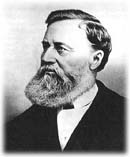 Isaac Singer was the eighth child of poor German immigrants in New York. He worked as a mechanic and cabinet maker, but his first love was the theater. Not finding financial success in acting, he turned to inventing. His first invention was a mechanical excavator.
Isaac Singer was the eighth child of poor German immigrants in New York. He worked as a mechanic and cabinet maker, but his first love was the theater. Not finding financial success in acting, he turned to inventing. His first invention was a mechanical excavator.
Singer patented a type-casting machine for book printing and displayed it in a steam-powered workshop run by Orson Phelps, who designed sewing machines. Phelps' customers kept returning the machines because of faulty design. Singer examined the machines and suggested improvements. Phelps' shuttle passed around a circle; Singer recommended that the shuttle move to and fro in a straight path. Instead of a curved needle that moved horizontally, Singer proposed a straight needle to be used vertically.
With Phelps' encouragement, Singer devoted his energies to the sewing machine from then on, and eventually made his fortune there. In 1851 he patented the first rigid-arm sewing machine. His design also included a table to support the cloth horizontally, a vertical presser foot, and a foot treadle.
He had an acute business mind and initiated important merchandising practices. A few of these included mass marketing, using women to demonstrate the machines, installment buying, and providing service along with sales.
Singer continued to be active in the sewing machine business until 1863, when he retired to live in Paris and London. He died in 1875 at the age of 63.
Allen Benjamin Wilson (1824-88)
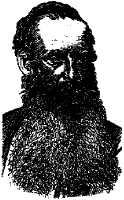 Born in New York State, Allen B. Wilson moved to Michigan in 1847 to work as a journeyman cabinet-maker. He began designing elements for a sewing machine, evidently unaware of similar efforts being made in New England.
Born in New York State, Allen B. Wilson moved to Michigan in 1847 to work as a journeyman cabinet-maker. He began designing elements for a sewing machine, evidently unaware of similar efforts being made in New England.
Wilson patented several sewing machine parts before becoming too ill to continue with his inventions. Among his most significant designs were those for a double-pointed, reciprocating shuttle, a rotary hook to replace the shuttle, and the four-motion feed.
He entered into partnership with manufacturer Nathaniel Wheeler, producing their first machine in 1851. In 1852, they organized as the Wheeler and Wilson sewing machine company, which was at the time the largest factory of its kind in the world, making 600 machines a day.
Wilson soon withdrew from the business and received a regular salary from patent renewals, but nowhere near as much as that received by Howe and Singer. When he applied for a second extension of his patents in 1874, he was turned down. The Congressional Committee on Patents felt that his four-motion feed was so necessary to a successful machine that renewing his patent would restrict competition.
Helen Blanchard's zigzag machine
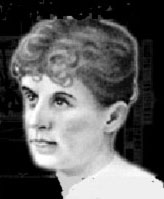 Helen Augusta Blanchard (1840-1922), a prolific inventor, held 28 patents, 22 of them dealing with sewing machines. She is particularly known as the inventor of the zigzag machine. The model of her 1873 overseaming machine can be seen at the Smithsonian's Museum of American History.
Helen Augusta Blanchard (1840-1922), a prolific inventor, held 28 patents, 22 of them dealing with sewing machines. She is particularly known as the inventor of the zigzag machine. The model of her 1873 overseaming machine can be seen at the Smithsonian's Museum of American History.
Blanchard, born into a wealthy Maine ship owner's family, showed early aptitude for mechanical inventiveness, although she received no formal training along that line. She patented her first invention after her family was left in financial straits by business losses suffered in the panic of 1866 and her father's death. She had to borrow money for her first patent fee.
In 1881 she established the Blanchard Over-seam Company of Philadelphia. Profits from this company and her other patents provided her with enough money to buy back the family homestead they forfeited earlier. As she became secure financially, she was very supportive toward other women less fortunate and was known for her generous, unpretentious manner.
Intro - - -
Technology - - -
Machines - - -
Impact - - -
Quotes - - -
Inventors
 |
This page
last updated: October 4, 2004
Original content: Copyright © 2000 - 2004 Museum of American Heritage
Trademarks are the property of their owners
|
 Not much is known about the life of Thomas Saint, the London cabinet maker who usually takes credit for patenting the first sewing machine in 1790. The patent was ponderously entitled, "An Entire New Method of Making and Completing Shoes, Boots, Splatterdashes, Clogs, and Other Articles, by Means of Tools and Machines also Invented by Me for that Purpose, and of Certain Compositions of the Nature of Japan or Varnish, which will be very advantageous in many useful Appliances." People overlooked it for 83 years because it was classed under wearing apparel.
Not much is known about the life of Thomas Saint, the London cabinet maker who usually takes credit for patenting the first sewing machine in 1790. The patent was ponderously entitled, "An Entire New Method of Making and Completing Shoes, Boots, Splatterdashes, Clogs, and Other Articles, by Means of Tools and Machines also Invented by Me for that Purpose, and of Certain Compositions of the Nature of Japan or Varnish, which will be very advantageous in many useful Appliances." People overlooked it for 83 years because it was classed under wearing apparel.
 It had a horizontal cloth plate or table, an overhanging arm carrying a straight needle, and a continuous supply of thread from a spool. A rotating hand crank on a shaft activated cams that produced all the machine's actions.
It had a horizontal cloth plate or table, an overhanging arm carrying a straight needle, and a continuous supply of thread from a spool. A rotating hand crank on a shaft activated cams that produced all the machine's actions.
 Born in New York, Walter Hunt spent most of his life as an inventor. He was known for his generosity, despite his lack of wealth.
Born in New York, Walter Hunt spent most of his life as an inventor. He was known for his generosity, despite his lack of wealth.
 The first man known to have put a sewing machine into practical operation, Barthelemy Thimonnier was a French tailor in the early 19th century. Noting that weaving was much faster than hand-sewing a garment, he began thinking of a method to mechanize sewing.
The first man known to have put a sewing machine into practical operation, Barthelemy Thimonnier was a French tailor in the early 19th century. Noting that weaving was much faster than hand-sewing a garment, he began thinking of a method to mechanize sewing.
 Massachusetts-born Elias Howe was inspired to invent a sewing machine when he was in ill health and his wife took in sewing to earn money. Watching her toiling at her stitches rekindled an earlier interest in such a machine.
Massachusetts-born Elias Howe was inspired to invent a sewing machine when he was in ill health and his wife took in sewing to earn money. Watching her toiling at her stitches rekindled an earlier interest in such a machine.
 Isaac Singer was the eighth child of poor German immigrants in New York. He worked as a mechanic and cabinet maker, but his first love was the theater. Not finding financial success in acting, he turned to inventing. His first invention was a mechanical excavator.
Isaac Singer was the eighth child of poor German immigrants in New York. He worked as a mechanic and cabinet maker, but his first love was the theater. Not finding financial success in acting, he turned to inventing. His first invention was a mechanical excavator.
 Born in New York State, Allen B. Wilson moved to Michigan in 1847 to work as a journeyman cabinet-maker. He began designing elements for a sewing machine, evidently unaware of similar efforts being made in New England.
Born in New York State, Allen B. Wilson moved to Michigan in 1847 to work as a journeyman cabinet-maker. He began designing elements for a sewing machine, evidently unaware of similar efforts being made in New England.
 Helen Augusta Blanchard (1840-1922), a prolific inventor, held 28 patents, 22 of them dealing with sewing machines. She is particularly known as the inventor of the zigzag machine. The model of her 1873 overseaming machine can be seen at the Smithsonian's Museum of American History.
Helen Augusta Blanchard (1840-1922), a prolific inventor, held 28 patents, 22 of them dealing with sewing machines. She is particularly known as the inventor of the zigzag machine. The model of her 1873 overseaming machine can be seen at the Smithsonian's Museum of American History.
